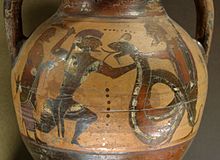Cadmus
| Cadmus | |
|---|---|
 | |
| Abode | Thebes |
| Personal information | |
| Born | Phoenicia, Tyre, Sidon or Thebes in Egypt |
| Parents | Agenor and Telephassa or Phoenix and Perimede |
| Siblings | Europa, Cilix, Phoenix |
| Consort | Harmonia |
| Children | Polydorus, Autonoë, Ino, Agave, Semele |
| Greek mythology |
|---|
 |
| Deities |
| Heroes and heroism |
| Related |
|
|
|


In Greek mythology, Cadmus (/ˈkædməs/; Greek: Κάδμος Kadmos), was the founder and first king of Thebes.[1] Cadmus was the first Greek hero and, alongside Perseus and Bellerophon, the greatest hero and slayer of monsters before the days of Heracles.[2] Cadmus was a prince of Phoenicia and he was of Argive Greek origin, the son of king Agenor and queen Telephassa of Tyre, the brother of Phoenix, Cilix and Europa. He could trace his origins back to Zeus. Originally, he was sent by his royal parents to seek out and escort his sister Europa back to Tyre after she was abducted from the shores of Phoenicia by Zeus.[3] In early accounts, Cadmus and Europa were instead the children of Phoenix.[4] Cadmus founded the Greek city of Thebes, the acropolis of which was originally named Cadmeia in his honour.
Cadmus' homeland was the subject of significant disagreement among ancient authors. Apollodorus identifies it as Phoenicia, but Tyre, Sidon, and even Thebes in Egypt are referenced in different accounts. His parentage is sometimes modified to suit, e.g. claims of Theban origin name his mother as one of the daughters of Nilus, one of the Potamoi and deity of the Nile river.[5]
Overview[]
Cadmus was credited by the ancient Greeks (such as Herodotus[6] c. 484 – c. 425 BC, one of the first Greek historians, but one who also wove standard myths and legends through his work) with introducing the original Phoenician alphabet to the Greeks, who adapted it to form their Greek alphabet. Herodotus estimates that Cadmus lived sixteen hundred years before his time, which would be around 2000 BC.[7] Herodotus had seen and described the Cadmean writing in the temple of Apollo at Thebes engraved on certain tripods. He estimated those tripods to date back to the time of Laius the great-grandson of Cadmus.[8] On one of the tripods there was this inscription in Cadmean writing, which, as he attested, resembled Ionian letters: Ἀμφιτρύων μ᾽ ἀνέθηκ᾽ ἐνάρων ἀπὸ Τηλεβοάων ("Amphitryon dedicated me [don't forget] the spoils of [the battle of] Teleboae.").
Although Greeks like Herodotus dated Cadmus's role in the founding myth of Thebes to well before the Trojan War (or, in modern terms, during the Aegean Bronze Age), this chronology conflicts with most of what is now known or thought to be known about the origins and spread of both the Phoenician and Greek alphabets. The earliest Greek inscriptions match Phoenician letter forms from the late 9th or 8th centuries BC—in any case, the Phoenician alphabet properly speaking was not developed until around 1050 BC (or after the Bronze Age collapse). The Homeric picture of the Mycenaean age betrays extremely little awareness of writing, possibly reflecting the loss during the Dark Age of the earlier Linear B script. Indeed, the only Homeric reference to writing[9] was in the phrase "γράμματα λυγρά", grámmata lygrá, literally "baneful drawings", when referring to the Bellerophontic letter. Linear B tablets have been found in abundance at Thebes, which might lead one to speculate that the legend of Cadmus as bringer of the alphabet could reflect earlier traditions about the origins of Linear B writing in Greece (as Frederick Ahl speculated in 1967[10]). But such a suggestion, however attractive, is by no means a certain conclusion in light of currently available evidence. The connection between the name of Cadmus and the historical origins of either the Linear B script or the later Phoenician alphabet, if any, remains elusive. However, in modern-day Lebanon, Cadmus is still revered and celebrated as the "carrier of the letter" to the world.
According to Greek myth, Cadmus's descendants ruled at Thebes on and off for several generations, including the time of the Trojan War.
Etymology[]
The etymology of Cadmus' name remains uncertain.[11] Possible connected words include the Semitic triliteral root qdm (Ugaritic: WIKI